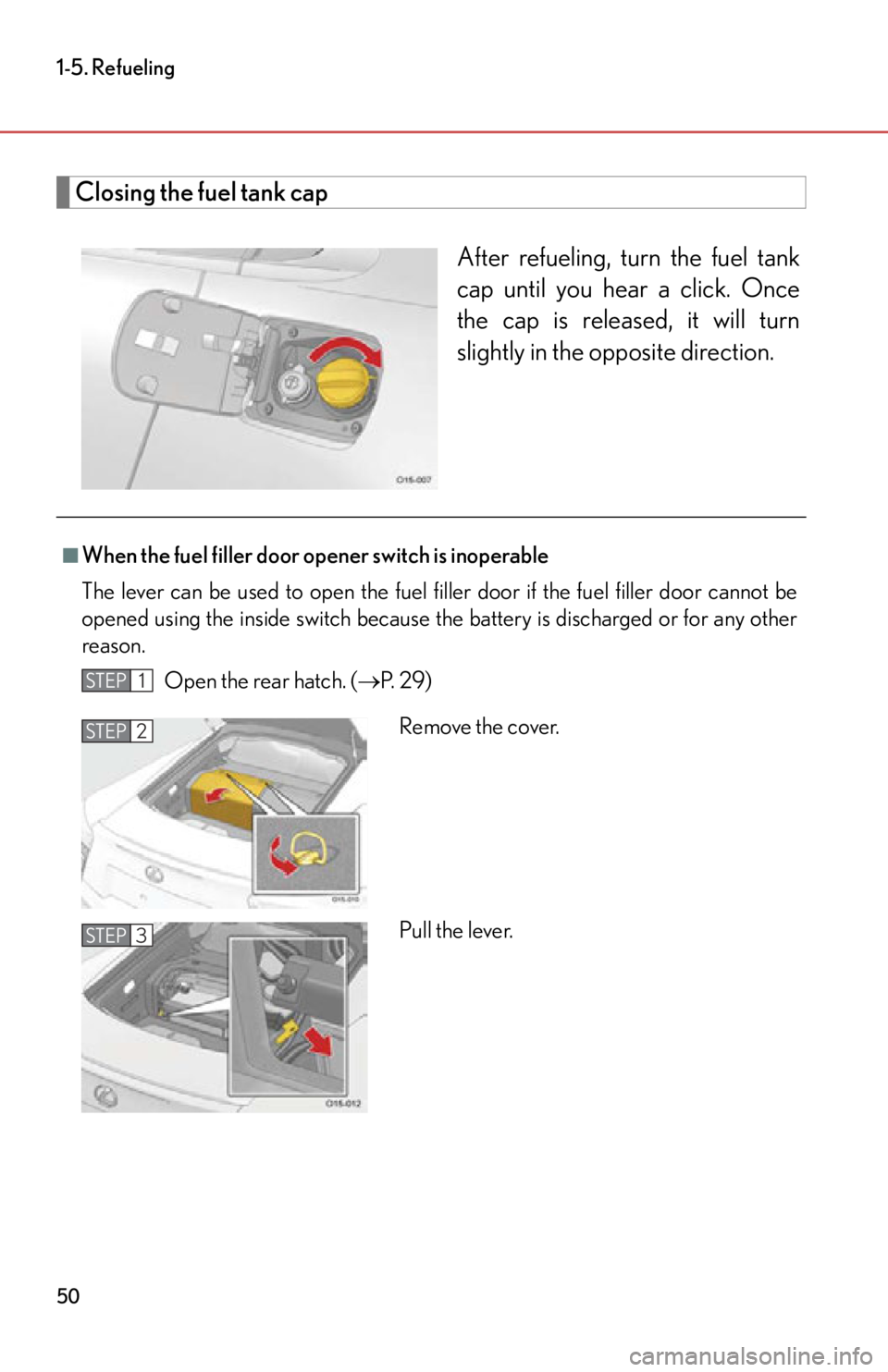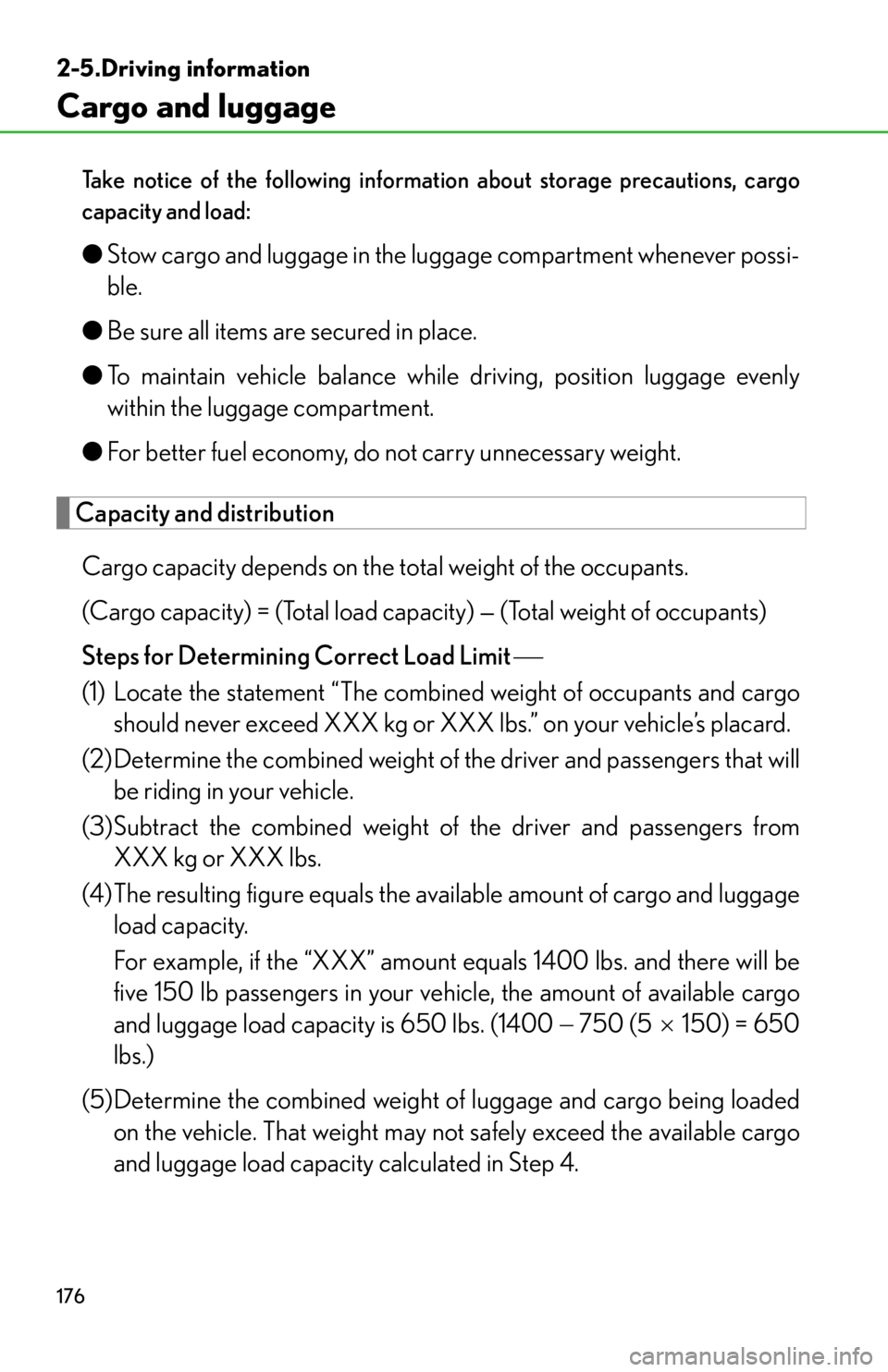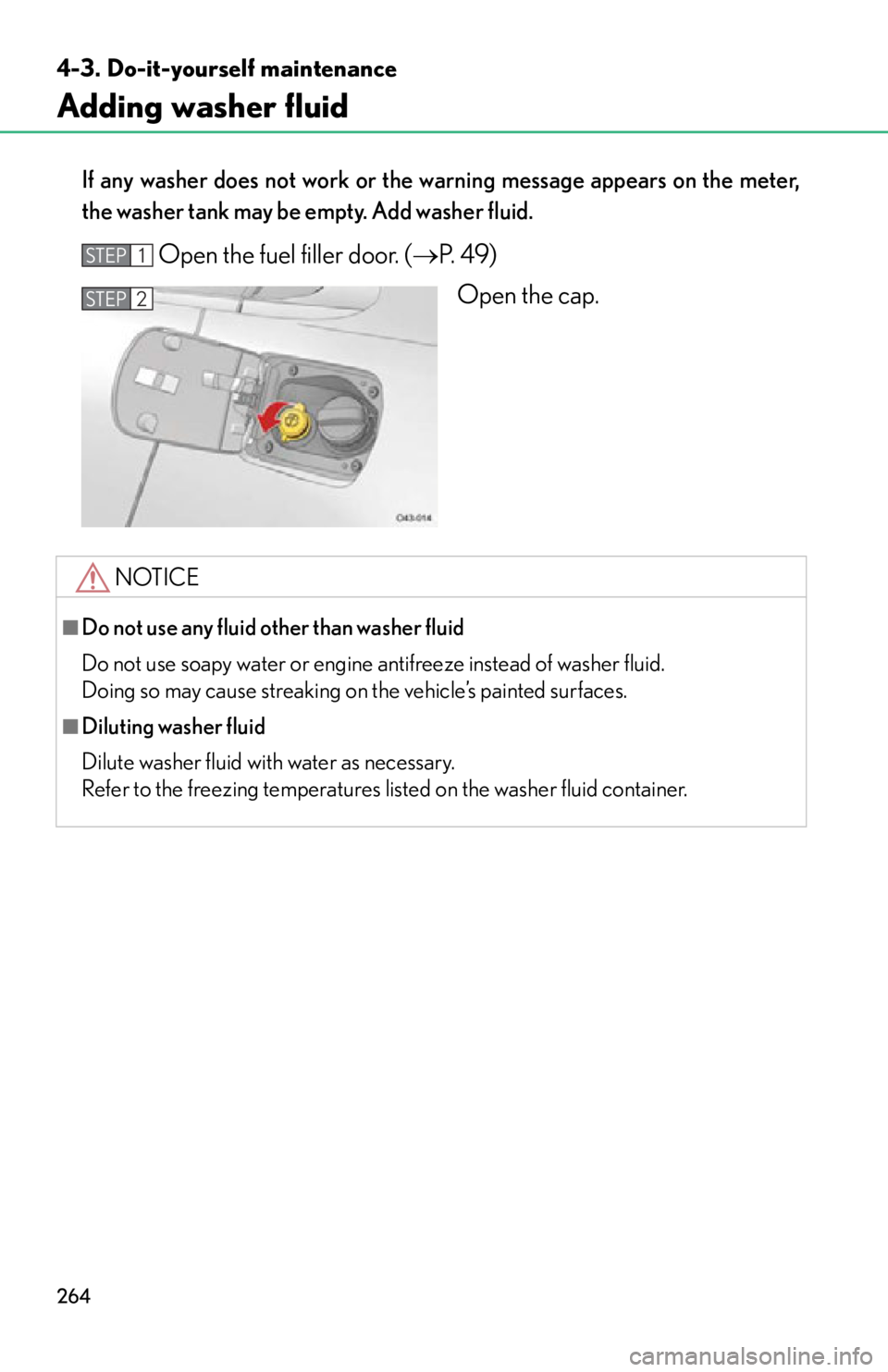fuel cap lexus LFA 2012 Technical Information / LEXUS 2012 LFA OWNERS MANUAL (OM77006U)
[x] Cancel search | Manufacturer: LEXUS, Model Year: 2012, Model line: LFA, Model: Lexus LFA 2012Pages: 420, PDF Size: 5.02 MB
Page 4 of 420

TABLE OF CONTENTSIndex
2
1-1. Key informationKeys ...................................................... 20
1-2. Opening, closing and locking the doors
Wireless remote control .............. 22
Doors.................................................... 25
Rear hatch .......................................... 29
1-3. Adjustable components (seats, mirrors,
steering wheel)
Seats ..................................................... 32
Seat belts ............................................ 36
Steering wheel................................... 41
Anti-glare inside rear view mirror ...................................... 42
Outside rear view mirrors ........... 43
1-4. Opening and closing the windows
Power windows................................ 46
1-5. Refueling Opening the fuel tank cap........... 49
1-6. Theft deterrent system Engine immobilizer system ......... 53
Alarm.................................................... 55 1-7. Safety information
Correct driving posture ............... 59
SRS airbags ........................................ 61
Passenger occupant classification system .................... 72
Child restraint sy stems ................. 76
Installing child restraints .............. 80
2-1. Driving procedures Driving the vehicle ......................... 88
Ignition switch ................................... 98
ASG (Automated Sequential Gearbox)................ 102
Turn signal lever............................... 112
Parking brake ................................... 113
Horn...................................................... 115
2-2. Instrument cluster Gauges and meters ....................... 116
Indicators and warning lights................................................... 121
Using the menu .............................. 124
2-3. Operating the lights and windshield wipers
Headlight switch ............................ 158
Windshield wipers and washer............................................. 160
1Before driving
2When driving
Page 21 of 420

Before driving1
19
1-1. Key informationKeys .............................................. 20
1-2. Opening, closing and locking the doors
Wireless remote control ......... 22
Doors ............................................ 25
Rear hatch ................................... 29
1-3. Adjustable components
(seats, mirrors,
steering wheel)
Seats............................................. 32
Seat belts ..................................... 36
Steering wheel ............................ 41
Anti-glare inside rear view mirror ............................... 42
Outside rear view mirrors ...... 43
1-4. Opening and closing the windows
Power windows .......................... 46 1-5. Refueling
Opening the fuel tank cap ..... 49
1-6. Theft deterrent system Engine immobilizer system.... 53
Alarm............................................ 55
1-7. Safety information Correct driving posture ......... 59
SRS airbags .................................. 61
Passenger occupant classification system.............. 72
Child restraint systems ............ 76
Installing child restraints......... 80
Page 51 of 420

49
1
Before driving
1-5.Refueling
Opening the fuel tank cap
Perform the following steps to open the fuel tank cap.
■Before refueling the vehicle
Turn the ignition switch to the “L OCK” position and ensure that both
side doors and windows are closed.
■ Opening the fuel tank cap
Press the opener switch.
Turn the fuel tank cap slowly to
open.
Hang the fuel tank cap on the back
of the fuel filler door.
STEP1
STEP2
STEP3
Page 52 of 420

50
1-5. Refueling
Closing the fuel tank capAfter refueling, turn the fuel tank
cap until you hear a click. Once
the cap is released, it will turn
slightly in the opposite direction.
■When the fuel filler door opener switch is inoperable
The lever can be used to open the fuel filler door if the fuel filler door cannot be
opened using the inside switch because th e battery is discharged or for any other
reason.
Open the rear hatch. ( P. 2 9 )
STEP1
Remove the cover.
Pull the lever.STEP2
STEP3
Page 53 of 420

51
1-5. Refueling
1
Before driving
CAUTION
■When refueling the vehicle
Observe the following precautions while refueling the vehicle.
Failure to do so may result in death or serious injury.
●Touch a metal surface (such as a static discharge plate if available) to discharge
any static electricity. As the vehicle body is made of resin touching the vehicle
body will not discharge static electricity.
Sparks resulting from discharging static electricity may cause the fuel vapors to
ignite.
●Always hold the grips on the fuel tank cap and turn it slowly to remove it.
A whooshing sound may be heard when the fuel tank cap is loosened. Wait until
the sound cannot be heard before fully removing the cap.
In hot weather, pressurized fuel may spra y out the filler neck and cause injury.
●Do not allow anyone that has not discharged static electricity from their bodies to
come close to an open fuel tank.
●Do not inhale vaporized fuel.
Fuel contains substances that are harmful if inhaled.
●Do not smoke while refueling the vehicle.
Doing so may cause the fuel to ignite and cause a fire.
●Do not return to the vehicle or touch an y person or object that is statically
charged.
This may cause static electricity to build up , resulting in a possible ignition hazard.
■When refueling
Securely insert the fuel nozzle into the fuel filler neck. When the fuel tank is filled to
the maximum level, the automatic shut of f function will engage. Do not continue
fueling once the automatic shut off function engages, as this may result in fuel over-
flowing from the tank.
■When replacing the fuel cap
Do not use anything but a genuine Lexus fuel tank cap designed for your vehicle.
Failure to do so may cause a fire or other incident which may result in death or seri-
ous injury.
Page 178 of 420

176
2-5.Driving information
Cargo and luggage
Take notice of the following information about storage precautions, cargo
capacity and load:
●Stow cargo and luggage in the luggage compartment whenever possi-
ble.
● Be sure all items are secured in place.
● To maintain vehicle balance while driving, position luggage evenly
within the luggage compartment.
● For better fuel economy, do not carry unnecessary weight.
Capacity and distribution
Cargo capacity depends on the to tal weight of the occupants.
(Cargo capacity) = (Total load capa city) — (Total weight of occupants)
Steps for Determining Correct Load Limit
(1) Locate the statement “The combined weight of occupants and cargo should never exceed XXX kg or XXX lbs.” on your vehicle’s placard.
(2) Determine the combined weight of th e driver and passengers that will
be riding in your vehicle.
(3)Subtract the combined weight of the driver and passengers from
XXX kg or XXX lbs.
(4)The resulting figure equals the av ailable amount of cargo and luggage
load capacity.
For example, if the “XXX” amount equals 1400 lbs. and there will be
five 150 lb passengers in your vehicle, the amount of available cargo
and luggage load capacity is 650 lbs. (1400 750 (5150) = 650
lbs.)
(5)Determine the combined weight of luggage and cargo being loaded
on the vehicle. That weight may no t safely exceed the available cargo
and luggage load capacity calculated in Step 4.
Page 248 of 420

246
4-2. Maintenance
Emission inspection and maintenance (I/M) programs
Some states have vehicle emission in spection programs which include OBD
(On Board Diagnostics) checks. The OBD system monitors the operation of
the emission control system.
■ If the malfunction indicator lamp comes on
The OBD system determines that a problem exists somewhere in the
emission control system. Your vehicle may not pass the I/M test and
may need to be repaired. Contact your Lexus dealer to service the
vehicle.
■ Your vehicle may not pass the I/M test:
●When the battery is disconnected or discharged
Readiness codes that are set during ordinary driving are erased.
Also, depending on your driving habits, the readiness codes may not
be completely set.
● When the fuel tank cap is loose
The malfunction indicator lamp comes on as a temporary malfunc-
tion and your vehicle may not pass the I/M test.
■ When the malfunction indicator lamp goes off after several driving
trips
The error code in the OBD system will not be cleared unless the vehi-
cle is driven 40 or more times.
■ If your vehicle does not pass the I/M test
Contact your Lexus dealer to prepare the vehicle for re-testing.
Page 266 of 420

264
4-3. Do-it-yourself maintenance
Adding washer fluid
If any washer does not work or the warning message appears on the meter,
the washer tank may be empty. Add washer fluid.
Open the fuel filler door. (P. 4 9 )
Open the cap.STEP1
STEP2
NOTICE
■Do not use any fluid other than washer fluid
Do not use soapy water or engine antifreeze instead of washer fluid.
Doing so may cause streaking on the vehicle’s painted surfaces.
■Diluting washer fluid
Dilute washer fluid with water as necessary.
Refer to the freezing temperatures listed on the washer fluid container.
Page 281 of 420

279
4-3. Do-it-yourself maintenance
4
Maintenance and care
■Tire inflation pressure check interval
You should check tire inflation pressure every two weeks, or at least once a month.
■Effects of incorrect tire inflation pressure
Driving with incorrect tire inflation pressure may result in the following:
●Reduced fuel efficiency
●Reduced driving comfort and tire life
●Reduced safety
●Damage to the drive train
If a tire needs frequent inflating, have it checked by your Lexus dealer.
■Instructions for checking tire inflation pressure
When checking tire inflation pressure, observe the following:
●Check only when the tires are cold.
If your vehicle has been parked for at least 3 hours or has not been driven for
more than 1 mile or 1.5 km, you will get an accurate cold tire inflation pressure
reading.
●Always use a tire pressure gauge.
The appearance of the tire can be mislea ding. In addition, tire inflation pressure
that is even just a few pounds off can affect ride quality and handling.
●Do not reduce tire inflation pressure after driving. It is normal for tire inflation
pressure to be higher after driving.
●Never exceed the vehicle capacity weight.
Passengers and luggage weight should be placed so that the vehicle is bal-
anced.
■Tire inflation pressure display
Tire inflation pressure can be checked on the meter's “Tire Pressure” display.
( P. 1 3 2 )
Page 319 of 420

5
When trouble arises
317
5-2. Steps to take in an emergency
■If the malfunction indicator lamp comes on while driving
First check the following:
●Is the fuel tank empty?
If it is, fill the fuel tank immediately.
●Is the fuel tank cap loose?
If it is, tighten it securely.
The light will go off after taking several driving trips.
If the light does not go off even after several trips, contact your Lexus dealer as soon
as possible.
■Electric power steering system warning light
When the battery is low or when the voltage drops temporarily, the electric power
steering system warnin g light may come on.
■Passenger detection sensor and passenger seat belt reminder
●If luggage is placed on the passenger seat, the passenger detection sensor may
cause the warning light to flash even if a passenger is not sitting in the seat.
●If a cushion is placed on the seat, the sensor may not detect a passenger, and the
warning light may not operate properly.
■When the tire pressure warning light comes on
Check the tire inflation pressure and adjust to the appropriate level. Pushing the tire
pressure warning reset switch will not turn off the tire pressure warning light. After
the tire inflation pressure is adjusted, it may take a few minutes for the tire pressure
warning light to go off.
■The tire pressure warning light may come on due to natural causes
The tire pressure warning light may come on due to natural causes such as natural
air leaks or tire inflation pressure changes caused by temperature. In this case,
adjusting the tire inflation pressure will turn off the warning light (after a few min-
utes).